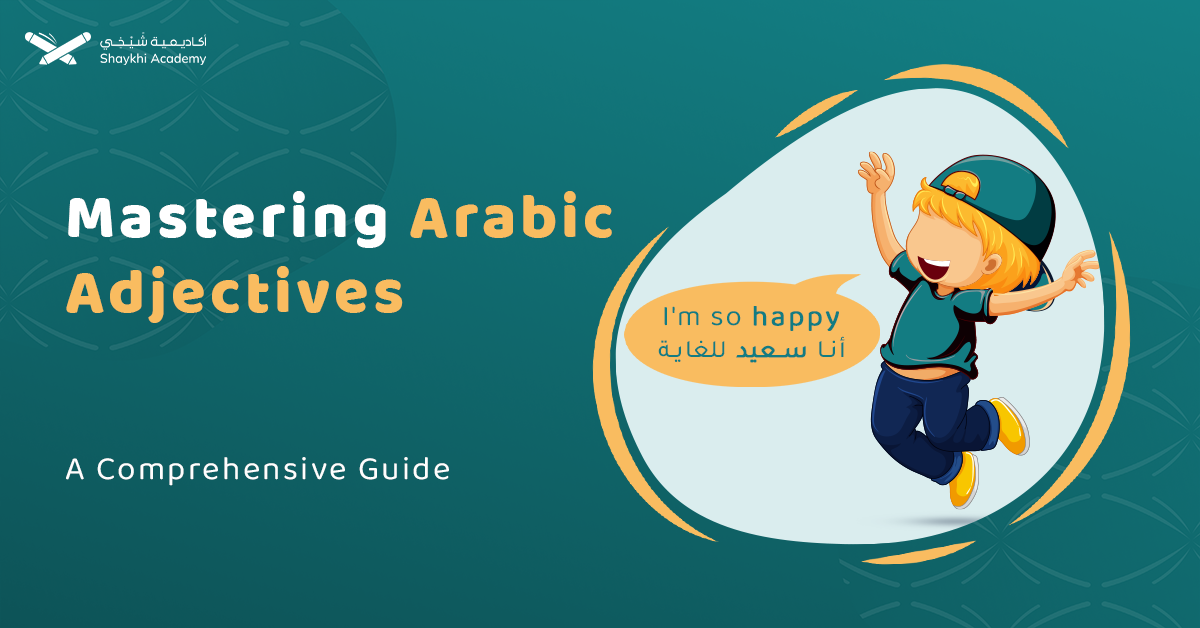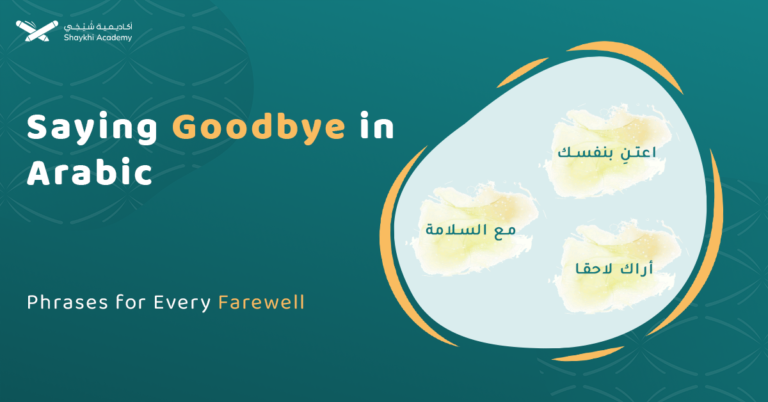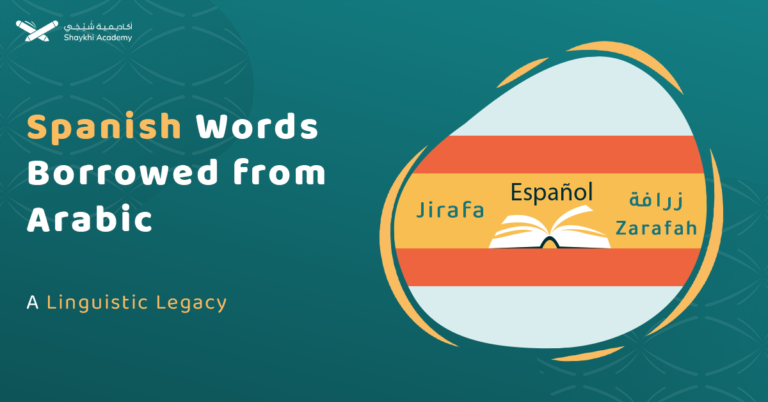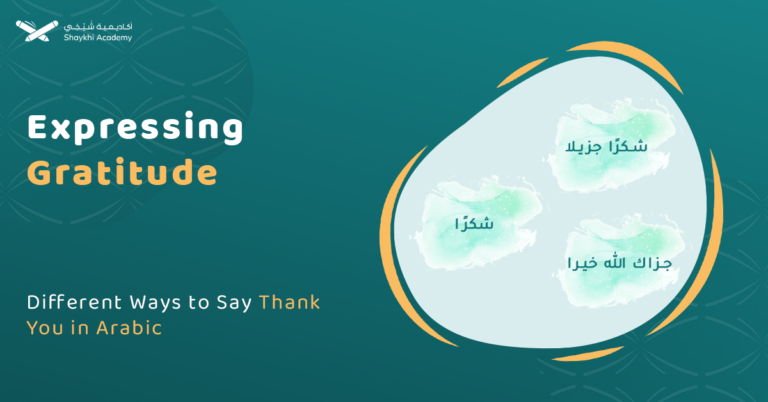Learning Arabic adjectives can help you achieve fast progress in the Arabic language. We all use adjectives extensively in our daily conversation. Arabic adjectives also have unique characteristics. You need to know these characteristics to use Arabic adjectives correctly inside the sentence.
In this topic, we will take a tour of Arabic Adjectives, their types, examples of beautiful Arabic adjectives, and how to use them in sentences so that you can describe them in Arabic fluently.
What Are Arabic Adjectives?
Arabic adjectives can be defined as a noun that describes a previous noun or pronoun. You will notice that, unlike in English, the adjective is placed inside the sentence after the described noun. Let’s make it clear with examples:
| English | beautiful girl. | Intelligent boy | Strong man | Strong woman |
| Arabic | بنت جميلة | ولد ذكي | رجل قوي | امراءه قوية |
In the former table, You can notice also that the adjective “strong” has 2 forms in Arabic قوي for masculine and قوية for feminine. We choose the form that is similar to the described noun. This is called Arabic Adjective conjugation and will be explained below.
Adjective Arabic describes the qualities of nouns in the language, but the adverb describes verbs. It has different patterns that are far from adjective patterns.
Arabic Adjective Agreement
Arabic Adjective Conjugation means that the Arabic Adjectives should be modified to suit the described noun. This is due to the rule that says:
“the Arabic Adjectives must agree with the described noun in terms of number, gender, definiteness, indefiniteness, and Irab “grammatical case”.
Here is a detailed explanation:
1. Numbers in Arabic Adjective
If the described noun is singular, the adjective should be singular. The examples in the table are all singular. If the described noun is pleural or dual “Muthana”, the adjective should be similar. The examples in the following table will clarify this.
| number | example | translation |
| Masculine dualمثني مذكر | الطالبان المجتهدان. | The two diligent students. |
| Feminine dual:مثني مؤنث | الطالبتان المجتهدتان. | The two diligent female students. |
| Masculine pluralجمع مذكر: | العاملون المصلحون. | The reformer workers. |
| جمع مؤنث: Feminine plural | العاملات المصلحات. | The female reformer workers. |
2. Gender in Arabic Adjective :
The Arabic adjectives should agree with the described noun in the gender. If the described noun is masculine, the adjective should be masculine, and vice versa.
In most cases, you can convert the adjective from the masculine form to the feminine form by adding the letter “ة”, but there are irregular adjectives.
Examples:
- The adjective مفيد” means useful when converted to the feminine form by adding” ة”. It becomes مفيدة.
- The adjective أكبر means “largest”. When converted to Feminine it becomesكبرى
3. Definiteness and indifiniteness:
In the Arabic language, we add the Article”ال” to indicate a known noun. This is called definite known. If the noun is indefinite, the adjective should be indefinite, and vice versa.
Simply, if you see the ال in the described name put it in the adjective.
| definite | المدرسة الجديدة | The new school |
| indefinite | مدرسة جديدة | A new school |
4. Irab “grammatical case – إعراب”:
The Irab إعراب of the described noun may be Nominative, Accusative, and Genitive.
The Irab of the adjective should be similar to the described noun. You can simply see the diacritics of the last letter of the described and put similar diacritics on the last letter of the adjective. Here are Examples for each case:
| Nominative | هي حديقةٌ جميلةٌ | It is a beautiful garden |
| Accusative | عملت عملاً رائعًا | you did a wonderful work |
| Genitive | العصفور في مكانٍ بعيدٍ | The bird is in a distant place. |
Arabic Colors and Defects
In the Arabic language, All colors have both masculine and feminine forms. Most Arabic colors have the Arabic pattern ‘Afaʿal= أفعل,’ which has the feminine form ‘Faʿlā=فعلاء.’ This also happens with Defects.
The Arabic pattern means adding specific letters to the root of the word, usually composed of “فعل”. In this case, we add the letter أ as a prefix in the masculine form”أفعل”. In the feminine form, we add the suffix “اء”, so it becomes “فعلاء”
Here is a detailed explanation:
1. Colors:
This table gives examples that follow the pattern, although there are irregular colors that do not follow this pattern. For example: Grey. “رمادي”. It is feminine form is رمادية
| colors | masculine | feminine |
| red | أحمر | حمراء |
| black | أسود | سوداء |
| white | أبيض | بيضاء |
| yellow | أصفر | صفراء |
| blue | أزرق | زرقاء |
| green | أخضر | خضراء |
2. Defects:
They are adjectives that have a pattern أفعل such as أعور, and أحول. They mean disabilities as you see in the following table.
| Defect | masculine | feminine |
| Blind in one eye | أعور | عوراء |
| dumb | أبكم | بكماء |
| deaf | أصم | صماء |
| bind | أعمي | عمياء |
Types of Adjectives in Arabic
The adjectives in Arabic describe the noun and provide more details about it. From this instance, Adjectives in Arabic have 3 types.
1. Single-word adjective:
When the adjective is composed of one word that agrees with the described noun as mentioned above.
For example:طفلة سعيدة. The word “سعيدة” is a single-word adjective.
2. Sentence as an Adjective:
When the adjective is composed of a whole sentence. This sentence can be a nominative or a verbal sentence. These sentences usually come after indefinite nouns. Here are more details about this:
a) nominative sentences:
In this type, the adjective is a complete nominative sentence grammatically composed of subject and predictive. The subject should have an attached pronoun that refers to the described noun.
See the following examples in the table below.
| sentence | translation | The described noun | The adjective | The attached pronoun |
| قابلُتٌ بنتًا أخلاقها حسنه. | I met a man of good character | بنتًا | أخلاقها حسنه | The pronoun “ها” in the word أخلاقها |
| شاهدت فيلمًا قصته جيدة. | I saw a film with a good story | فيلمًا | قصته جيده | The pronoun “ه” in the word قصته |
b) verbal sentences:
In this type, the adjective is composed of a complete verbal sentence grammatically that is composed of a verb and a subject at least. The subject can be a Hidden or Implied Pronoun.
For example:
| sentence | Translation | The described noun | The adjective |
| رأيت طالبًا يغني | I saw a student singing. | طالبًا | يغني |
| رأيت بنتًا تلعب بالكرة | I saw a girl playing. | بنتًا | تلعب بالكرة |
3. Phrase as an Adjectives:
When the adjective is composed of a Prepositional Phrase (جار ومجرور) or Circumstantial Phrase (ظرفية). In this type, the adjective gives more details about the described noun. These details are usually related to its state or its place.
Here is a detailed overview.
a) Prepositional Phrase (جار ومجرور) as a phrase adjective.
The prepositional phrase is composed of a Preposition and a noun in the genitive case. When this phrase describes a previous noun it acts as an adjective for this word.
For example
I saw books on the table….رأيت كتبًا على المنضدة
b) Circumstantial Phrase (ظرفية) as a phrase adjective.
Circumstantial Phrase is composed of an adverb for the place or the time. When this phrase is used to describe a previous noun.
For example
I saw the bird is above the car……رأيت العصفور فوق السيارة
Feminine Adjectives in Arabic
Most Adjectives in Arabic are converted to feminine by adding the letter “ة” to the masculine form. This rule has a few exceptions including some colors and defects.
Another exception to this rule is the adjectives that are used for women only such as pregnant=حامل, breastfeeding=مرضع, and Menstruating womanحائض. In these adjectives, you can add the letter” ة” but it will be correct but influential. You can explore more details about Arabic grammar in our Fusha Arabic Course.
Read more about Arabic Negation And Its Types, Structures, and Examples of Negating Verbs and Sentences
Arabic Relative Adjective
Arabic relative adjectives are adjectives that indicate an attribute or identity associated with a certain noun. It is usually formed by adding the suffix “ي”. See the following table:
| Relative adjective | translation |
| رئيسي | principal |
| ضروري | necessary |
| مصري | Egyptian |
These adjectives’ meanings are related to the described person, this is called in Arabic “ nisba” which means relative. The relative adjectives can be used as nouns.
Read more about Arabic Adverbs – أَحوَال (ʾaḥwal) And The Five Direct Objects (المفعولات الخمسة)
Top Arabic Adjectives List
The Arabic language is characterized by the presence of many adjectives to describe the same case according to the potency of the adjective. This makes the Arabic language full of adjectives that can be used for more a precise description.
The abundance of synonyms and variants for the same adjective makes the Arabic language rich and colorful.
This table provides some most common adjectives with their pronunciation to help you speak Arabic in your daily conversation. If you need to speak Arabic during conversations, take a look at our Arabic-speaking course.
| adjective | Meaning | Transliteration |
| سريع | Quick | Sarīʿ |
| بطيء | slow | batii |
| جديد | New | Gadid |
| قديم | old | Qadim |
| قريب | Near | Qarīb |
| بعيد | Far | Baʿīd |
| غالي | Expensive | Ghali |
| رخيص | Cheap | Rakhis |
| مريح | Comfortable | Murih |
| متعب | uncomfortable | Mtib |
| ممتع | Enjoyable | mumti3 |
| ممل | boring | Mumil |
| ملئ | Full | mliia |
| فارغ | Empty | Fārigh |
| مفتوح | Open | Maftouh |
| مغلق | closed | Mughlaq |
| حار | Hot | Ḥār |
| بارد | Cold | Bārid |
| صحيح | Correct | Ṣaḥīḥ |
| خاطئ | Wrong | Khāṭiʾ |
| قاسٍ | Rough | Qāsīn |
| ناعم | Soft | Nāʿim |
| ثقيل | Heavy | Thaqīl |
| خفيف | light | Khafīf |
| حلو | Sweet | Ḥulw |
| مر | Bitter | Murr |
| بسيط | Simple | Basīṭ |
| عظيم | Great | Basīṭ |
| معقد | Complex | Muʿaqqad |
| مستحيل | Impossible | Mustaḥīl |
| ممكن | possible | Mumkin |
| ضيق | tight | Ḍayyiq |
| واسع | wide | Wāsiʿ |
| متأخر | Late | Mutaʾakhkhir |
| مبكر | Early | Mubakkir |
| مضحك | Funny | Muḍḥik |
| ضار | harmful | Ḍārr |
| مفيد | useful | Mufiid |
| غريب | Strange | Ghariib |
| مرتفع | high | Murtafiʿ |
| منخفص | low | Minkhafed |
| واضح | Obvious | Wāḍiḥ |
| غامض | Ambiguous | Ghāmiḍ |
| مكتظ | Crowded | Muktāẓ |
Arabic Adjectives to Describe a Person
If you want to describe a person, you will use either moral or physical adjectives. It is noteworthy to say that the adjectives in Arabic can be modified to indicate superlative property by using the pattern “أفعل”. For example, أكبر means the largest. There are specific patterns that indicate the intensity of the adjective. For example, صابر means patient but صبور means more patient. Here are examples of beautiful Arabic adjectives.
- Physical adjectives:
| adjective | translation | transliteration |
| قصير | short | Qaṣīr |
| طويل | tall | Tawiil |
| نحيل | thin | Nahiif |
| سمين | fat | Saamiin |
| جميل | beautiful | Gamiil |
| قبيح | ugly | Qabīḥ |
| قوي | strong | Qawii |
| ضعيف | weak | Ḍaʿīf |
- Moral adjectives:
| Adjective | Translation | Transliteration |
| صادق | Trustworthy | Ṣādiq |
| كاذب | Lair | Kādhīb |
| أمين | Honest | Amīn |
| كريم | Generous | Karīm |
| بخيل | Stingy | Bakhīl |
| شجاع | Brave | Shujāʿ |
| جبان | Cowardly | Jabān |
| عادل | Fair | ʿĀdil |
| ظالم | Unfair | Ẓālim |
| طيب | Kind | Ṭayyib |
| قاس | Stiff | Qāsī |
| عجول | Impatient | ʿAjūl |
| مجتهد | Hardworking | Mujtahid |
| كسول | Lazy | Kasūl |
| متفائل | Optimistic | Mutafāʾil |
| متشائم | Pessimistic | Mutashāʾim |
| طماع | Greedy | Ṭamāʿ |
Arabic Adjective Sentences
When you read more sentences and try to find out the adjectives, you will be familiar with these adjectives. This can help to keep the meaning of the adjective by the word. The following table provides some Arabic adjective sentences. Try to guess the type of adjective and make sure of the Adjective conjugation. You can find more in our Arabic reading course.
| sentence | translation | adjective |
| شاهدتُ رجلًا فقيرًا. | I saw a poor man | فقير |
| يلجأ الإنسانُ المتعبُ إلى الحديقة | The exhausted person goes to the garden. | المتعب |
| جاء الطالبُ النشيطُ. | The active student comes | النشيط |
| رأيت الشمس المشرقة | I saw the rising sun | المشرقة |
| رأيت العصفور يغرد | I saw the singing bird | يغرد |
| رأيت العصفور فوق الشجرة | I saw the bird above the tree | فوق الشجرة |
| رأيت عصفورًا صوته جميلًأ | I saw a bird with a beautiful voice | صوته جميلا |
| هذا طفل جميل | It is a beautiful boy | جميل |
| هذه شجرة طويلة | It is a tall tree | طويلة |
| هاتان بنتان رفيعتان | These are two thin girls | رفيعتان |
| هؤلاء عمال مجتهدون | These are hard workers | مجتهدات |
| هن أمهات مرهقات | They are exhausted mothers | مرهقات |
| هذان ولدان شريران | These are two bad boys | شريران |
Learn more about Arabic Adjectives and grammar with Shaykhi Academy:
Practice Arabic adjectives to master them in our online Arabic course. Our specialized Arab tutors simplify the grammar for beginners with no prior knowledge of Arabic. We can help also to improve your language skills.
We provide many teaching techniques to suit different mental abilities such as videos, audio, virtual classrooms, and live sessions with instructors. No matter where you are, you can begin right now.
Why Shaykhi Academy?
- Expert Native Tutors: Learn from highly qualified native Arabic speakers.
- Flexible Scheduling: Tailor your classes to fit your busy life.
- Affordable Learning: Access top-quality education at a price that suits you.
- Global Access: Study from anywhere in the world.
Explore Our Arabic Courses:
- Noorani Qaida: Build a strong foundation in Quranic Arabic.
- Comprehensive Arabic Courses: Master the Arabic language, from beginner to advanced levels.
- Fusha Arabic Classes: Delve into Modern Standard Arabic, the key to understanding literature, media, and formal communication across the Arab world.
- Quranic Arabic Course: Enhance your connection with the Quran by learning the language in which it was revealed.
Start Your Arabic Journey Today! Whether you’re just starting or looking to deepen your knowledge, Shaykhi Academy is here to support your journey. Book your free trial now and begin your path to Arabic mastery!

Conclusion:
The Arabic adjectives play an important role in everyday conversations. Mastering their use can help you understand and practice the language. The adjectives in Arabic depend on the described noun in number, gender, the grammatical case “Irab”, definiteness, and indefiniteness.
There are three main types of adjectives: single-word adjectives, phrase-like adjectives, and whole-sentence adjectives. There are many beautiful adjectives. Keeping many adjectives makes you able to describe more precisely.


















































